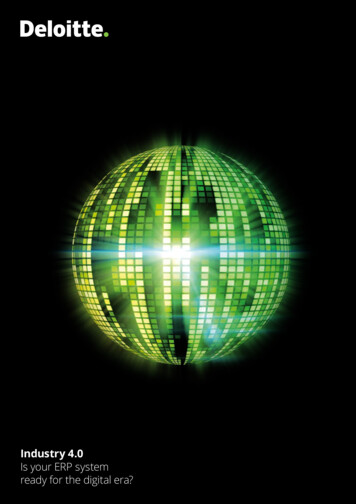
Transcription
Industry 4.0Is your ERP systemready for the digital era?
Investing in Germany A guide for Chinese businesses Industry 4.0 stands for disruptive changecaused by the expansion of the Internet ofThings and by Cyber-Physical Systems inproduction and logistics. The term includesinnovations such as intelligent productsand processes, a deeper integration alongthe supply chain, and digital technologiesin production. The aim is a faster reactionto increasingly variable customer demand,resulting in increased competitiveness indynamic, volatile markets. This studyassesses available SAP technologies inthe area of enterprise resource planning,illustrates the successful implementationof Industry 4.0 in an integrated conceptwith the help of use cases, and makesrecommendations.02
Industry 4.0 Is your ERP system ready for the digital era?Deloitte in the Digital Era05Our under standing of Industry 4.006The path towards the fourth industrial revolution07Goals for strategy, organization, and processes08Demands on ERP Systems made by Industry 4.010Technical requirements11Process-related requirements16Assessment of existing SAP technologies20ERP system classes: status quo,evolution and revolution22Connection of ERP systems to the shop floor29Conclusion: an initial but very essential step32Use cases: successful examples in the area of ERP36Deloitte-M4.0-Cube: integration of use cases37Conclusion44Result and possible improvements45 ifferent ways to approach Industry 4.0 with DeloitteDas acompetent partner46Contact4803
Investing in Germany A guide for Chinese businesses
Industry 4.0 Is your ERP system ready for the digital era?Deloitte in the Digital EraDeloitte is one of the largest audit andconsulting companies in the world. Unlikeother consulting companies, we offer abroad variety of consulting services indifferent areas. These span the conceptualization of future-oriented strategies, theestablishment of optimized processes, thetransformation of a whole organization,and the implementation of innovativetechnologies. We always strive for the bestsolutions and we therefore make use ofour network – which consists of more than250,000 experts worldwide – to respond inan optimal way to clients’ requirements.Industry 4.0 as a cross-functionaltopic: our strengthAs all business functions and processesare affected by Industry 4.0, Deloitte is theideal partner for mastering this theme.Disruptive technologies such as the Internet of Things (IoT), Big Data, and Analyticsprovide an opportunity to improve currentprocesses or to develop processes whichhave not been realizable up to now. Processes change but so do the roles andresponsibilities of employees: rather thanbeing machine operators they becomeshapers and controllers of smart, connected systems. Companies that engage inIndustry 4.0-oriented process changes areconstantly communicating with their business partners. Hence, new products andservices can be offered which influence thecompany’s strategy and business model.Enterprise Resource Planning:still the company’s backboneIn recent years, Enterprise ResourcePlanning (ERP) systems such as SAP ERPECC and SAP S/4HANA have become thecentral instance for the planning, control,and execution of all business processes,due to the advantages of depicting allbusiness-relevant data in, and accessing itfrom, one system. Industry 4.0 is not goingto change this, but the role of ERP systemswill change. The focus will shift from centraldata collection to the support of mobile,role-based user interactions. Thanks toreal-time data access and intelligent dataanalyses, the efficiency and transparencyof process execution can be increasedsignificantly.We want to share with you the ERP andIndustry 4.0 expertise we have developed.In the following sections we outline thechallenges as well as process-related andtechnical requirements for ERP systems inIndustry 4.0 and present the ERP systemsbest suited to supporting Industry 4.0.Our competencies in EnterpriseResource Planning and Industry 4.0But this does not happen automatically.Every company needs a tailored conceptto make optimal use of its data. It is onlythen that the company will be able to adaptflexibly and dynamically to the changesdemanded by the market. Innovative datamanagement – which will be presentedlater on in this paper – must therefore bedeveloped. Deloitte represents a reliableand competent partner in designing andrealizing such data management as wehave more than 12,000 experts in the areaof enterprise applications, especially SAP,who assist in implementing and enhancingERP systems.05
Investing in Germany A guide for Chinese businesses Ourunder standingof Industry 4.0Owing to the growing uncertainty in the marketand the customer’s desire for more individualizedproducts, companies are coming under pressureto make their production and logistics processesmore flexible. The key word is Industry 4.0. The entire IT infrastructure must therefore be re designed –this includes systems for the planning, control, andexecution of production and logistics. The key toprocess integration is innovative data managementwith an Enterprise Resource Planning (ERP) systemas central planning instance. First, the term Industry 4.0 and its relation to a company’s EaRP systemwill be defined.06
Industry 4.0 Is your ERP system ready for the digital era?The path towardsthe fourth industrialrevolutionAfter mechanization with the help of waterand steam power in the late 18th century,the standardization and division of laborthat enabled mass production in the early20th century, and the electrification andfurther automation of production in the1970s, we are now experiencing anotherchange: the fourth industrial revolution –Industry 4.0. Industry 4.0 presents opportunities and challenges but it represents achange that companies need to come toterms with in order to stay competitive inthe market.The Internet of Things in productionand logisticsOur understanding of Industry 4.0 is theapplication of the Internet of Things (IoT) toindustrial processes. This refers especiallyto the representation of physical objectssuch as machines, tools, workpieces, andworkpiece carriers and their equipment inthe digital world, with the ability to communicate with other objects. These resultingsmart objects are connected with each other and together they build a system whichallows for more flexible, more efficient, andmore transparent planning, control, andexecution of production and logistics. Thisalso requires changes along the supplychain and in work organization and adapting business models and services.Technical pillars of the developmentThe interconnectedness of physical objectsfacilitates innovative, decentrally controlledproduction systems which permit theproduction of small lot sizes and a rangeof product variants. This developmentis mainly enabled by the miniaturizationand increased performance of microelectronics, communications, and informationtechnology. But technologies which can belinked to Big Data are just as important forthe implementation of Industry 4.0. Thisaffects the storage, exchange, and effectiveuse of large amounts of data arriving athigh speed from different data sources.Moreover, technologies for data input andoutput such as 3D scanners, virtual realityglasses, and mobile devices are needed.Technical integration of Cyber-PhysicalSystemsCyber-Physical Systems (CPS) are frequentlymentioned in connection with Industry 4.0.Sometimes Industry 4.0 is even used as asynonym for the technical integration ofsuch systems in production and logistics.CPS refers to the involvement of computational logic in physical processes. Embedded, connected computers monitor andcontrol physical processes in a closed-loopcontrol in such a way that the physical process and the computational logic influenceone another. Machines and products aretherefore equipped with sensors, actuators, and a connection to the company’scommunications network. The embeddingof the products as active components inthe CPS is essential. This way workpiecesand workpiece carriers hold all necessaryinformation for executing and controllingtheir production themselves.The ERP system as an essential part ofa Cyber-Physical SystemThe purpose of ERP systems is to serveas the central instance for master andtransactional data in all business-relatedprocesses in companies. With the help ofinterfaces, ERP systems are connected toinput and output devices such as scanners,illustration and communication devicesand also to other hardware-software-systems within and across companies. Consequently, the ERP system can be seen asan essential part of the CPS network andtherefore needs to be taken into account inintegrated Industry 4.0 concepts. However,new, flexible processes and especially thedissolution of the paradigm that all company data has to be stored centrally posea challenge to ERP systems. This is why thestudy examines how different SAP technologies can support Industry 4.0.07
Investing in Germany A guide for Chinese businesses Goals for strategy,organization, andprocessesIndustry 4.0 aims at making productionand logistics processes (which are currentlyplanned, controlled, and executed statically) more dynamic. Industry 4.0 thereforealso has an impact on all performancelevels and processes which companiesdeal with to create value for the customer.Such performance layers – which will belater used to illustrate use cases – are forexample the IT infrastructure, operationalprocesses, planning, and controlling. Onthe other hand, knowledge, capabilities, thecompany‘s culture, organizational structures, and strategic targets also presentareas for change. Thus the goals of Industry4.0 can be divided into three categories:strategy, organization, and processes, asshown in Figure 1.Fig. 1 – Goals of Industry 4.0Strategy Shorter time-to-market for a fast reaction to new customerdemands Higher robustness to volatile customer demandOrganization Increased quality of work through an improved work-life-balance Diversified tasks through the automation of routine jobs User-centric work environment through innovative man-machine-interactionProcessesIndustry 4.0 hasimplications for allperformance areas andbusiness functions of acompany. New business models and services through digitalized products Saving of time through more efficient and more transparentproduction processes Higher flexibility through dynamic planning, control,and execution Higher productivity and resource efficiency for individualizedproducts Shorter lead times through the application of intelligent analyses Different work organization through mobile process controland execution Increased quality through predictive error avoidance08
Industry 4.0 Is your ERP system ready for the digital era?09
Investing in Germany A guide for Chinese businesses Demands onERP Systems madeby Industry 4.0If the ERP system is to be used in a CPS environmentto support Industry 4.0, it must fulfill a variety oftechnical and process-related requirements whichare described below.10
Industry 4.0 Is your ERP system ready for the digital era?Technical requirementsData becomes more and more the key tothe planning, control, and execution of allactivities along the supply chain. That iswhy companies must handle all data withcare and make wise use of them. Companies must look for new ways of using dataand need to exploit the opportunities oftheir data security to create an effectivebasis for decision-making. The main challenge here is innovative data management.For us, innovative data management is acomprehensive, long-term concept whichmaximizes the value of data for the business and includes the storage, exchange,and use of data. The development andimplementation of such concepts must beencouraged, as only data which is error- free, up-to-date, accessible, and usablecan contribute to the company’s success.In conclusion, technical challenges leadto technical requirements (TR1, TR2, andTR3) for ERP systems which are shown anddescribed in Figure 2.Fig. 2 – Technical requirements for ERP SystemsTR1Data storageSimplification of data model: Simple table structures for the logical data model of ERP systems Goal: abandonment of intermediate results (timeliness of data)Decentralized data management: Distributed storage of data in different systems Goal: dynamic, bi-directional (ERP-MES-PLC) loading of data to control processes flexiblyTR2Data exchangeConnection to legacy systems: Exchange (vertical and horizontal) and processing of data with and from different hardware-software systems Goal: integration of systems for a flexible planning, control and executionSpeed of data access: ERP system should deliver requested data within short response times Goal: fast reaction to changes which are on short noticeTR3Data useVisualization: The user interface of the ERP systems should display information adequately (i.a. display on different devices),understandingly und intuitively Goal: improvement of human-machine interactionIntegration and Intelligence: ERP system should connect data from different sources and hence create new information Goal: generation of new informationAutomation: ERP system should use the data to trigger automated processes Goal: reduction of errors and increase in efficiency11
Investing in Germany A guide for Chinese businesses TR1 – Data storage: logically simplifiedand physically distributedThere are two perspectives on data storage, the logical and the physical. The logicalperspective describes the data modeland hence the structure of the databasewhich serves as the central instance for thecompany‘s data management. Typically, anERP system is based on a number of tableswhich store fundamental data as single entries, aggregated intermediate results, andcondensed data. For classic ERP systemsthese condensed data are based on computation routines which can be executedat predefined time intervals only. This isdue to a lack of performance which leadsto data not being up-to-date. An examplewould be the posting of inventory betweenstorage locations. The flexibility which isnecessary for Industry 4.0 is only achievable if the planner is able to access the mostcurrent data from all business functions.This requires the development and implementation of a simplified data modelwhich allows access to a current, single setof data at all times and which also updatesupstream results.The physical perspective of data storage isthe physical place where data is stored andmanaged. There are two opposing ways ofstoring data, namely completely centrallyand completely decentrally. The centralizedapproach represents the main idea of ERPsystems where all important companydata are stored in one place in order toavoid redundancies and inconsistencies.Nevertheless, this increases the size of thecentralized database which requires noveltechnologies for efficient data processing.Thinking about flexibly controlled production reveals that not all data are available inadvance and thus cannot be stored centrally. For example, when it is not desirableto assign an order sequence, the workpiecehas to be identified dynamically. Then somedata such as the workpiece’s identifier andin some cases also work instructions have tobe stored decentrally on the workpiece itself.12On the other hand it is possible to storedata decentrally where there is no hierarchy of IT systems. In such a scenario, theindependent systems start communicatingwith each other when there is the need tosolve temporary tasks such as finding thenext work station for the processing of thework piece. This theoretically achieves thedesired flexibility. Nevertheless, there is noway to avoid redundancies and inconsistencies in that case. General data such as, e.g.,the organizational structure and materialmaster data have to be managed centrally.Moreover, it is also important for flexibleproduction to plan sequences in advancein order to have sufficient resources (personnel, budget, etc.) available. This is whyit is a challenge in Industry 4.0 to balancecentralized and decentralized data storageto avoid redundancies and inconsistencies,allow for planning, and realize the desiredflexibility. This is summarized in Figure 3.Fig. 3 – Data storageCentralizedDecentralizedThe main component of innovative datamanagement is the smart combination ofcentralized and decentralized data storage.
Industry 4.0 Is your ERP system ready for the digital era?Fig. 4 – Data exchangeHorizontal IntegrationgratPionERCustomerVeESrtiMcal InteSupplierPLCManufacturerVertical Integration: Exchange of data between the ERP system, the MES, and the shop floorHorizontal Integration: Exchange of data along the supply chain through the integration of customers and suppliersTR2 – Data exchange: integrated andimmediateAs companies interact with other partiessuch as suppliers, institutions, and customers beyond their boundaries, an ERPsystem has to be able to support end-toend processes and to exchange data withthese external parties. This horizontal integration facilitates the consistent availabilityof customer and supplier data. Horizontalintegration is one of the strengths of ERPsystems, thanks to their existing interfaces.A vertical integration of the planning, control, and execution levels in the companyadditionally enables flexible control ofproduction and logistics processes. Forexample, production orders are exchangedbetween the planning level, ERP system,and the execution level, manufacturingexecution system (MES). The latter then exchanges data with the machine’s programmable logic control (PLC). The challengethat arises is hence the connection of theERP system in two directions – horizontaland vertical (see Figure 4).The flexible planning,control, and execution ofproduction requires verticaland horizontal connectionof data generated bydifferent systems.13
Investing in Germany A guide for Chinese businesses For horizontal integration beyond thecompany‘s boundaries it is vital to defineand establish communication standardsfor data security and to avoid data manipulation. As the IT systems of the differentsupply chain partners communicate usinga number of interfaces it has to be ensuredthat the technologies are capable of beingintegrated.Apart from the possibility of connecting different systems with each other, the speedof the data access of ERP systems andconnected data sources is another challenge that presents itself. As mentionedearlier when discussing logically simplifieddata storage, the planner has to be able toaccess the most up-to-date data to supervise and, if necessary, influence productionand logistics processes. This is why ERPsystems need to have minimal responsetimes. If data is stored in different places,data exchange is essential for process execution and immediate data access is evenmore important. It is thus obvious that aconcept for innovative data managementmust integrate the storage, exchange and –to be explained next – use of data.14TR3 – Data use: intuitively displayed,integrated and automatedTo maximize the potential of company datait is important not only to store and exchange data but also to use them effectively and efficiently. Such advanced data usehas to be applied to all data, independentlyof their storage location – but especially tothe data which are physically distributed.For us, advanced data use also considersuser-friendly human-machine interaction,data connection among different companies, and the automation of businessprocesses. The challenge is the realization.Over recent decades, companies havecollected large amounts of data but theyare still at an early stage of using it wisely.The reason for this is that the existing datahave to be connected intelligently to new information. Only if large amounts of data areconnected can Big Data become Smart Data.An example is the collec
The focus will shift from central data collection to the support of mobile, role-based user interactions. Thanks to . the fourth industrial revolution – Industry 4.0. Industry 4.0 presents oppor - . and also to other hardware-software











